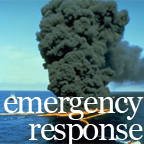|
|
 Home | Image Galleries | Emergency Response Home | Image Galleries | Emergency Response
Mearns Rock Time Series
A photo time series of Mearns Rock, a large boulder located in the intertidal zone at Snug Harbor on Knight Island, Prince William Sound, Alaska.
Click on the image to return to the gallery
|

Mearns Rock 1997
What You See
The boulder is once again covered (about 80%) with the seaweed Fucus. There are several age groups of Fucus on the boulder. Young Fucus is growing over the top section of the boulder and adult Fucus is growing around the mid-portion. The beach face is again rich with seaweed. No mussels are visible and the areas occupied by the barnacles have shrunk. (Which other photo does the boulder resemble now?)
What's Happening
Starfish and sea otters may have been preying on the mussels, and a predatory snail, Nucella, has likely been eating the barnacles. (Although you can't tell from the photo, the Nucella population has been slowly growing on the boulder.)
(07.01.97, Snug Harbor, Knight Island, Alaska)
|
|
| Related Pages on Our Site |
- Exxon Valdez Oil Spill Overview of the 1989 Exxon Valdez oil spill in Prince William Sound, Alaska. Includes links to many related resources, including photo galleries.
|
- Graphing Changes in Marine Life Abundance Try your hand at some marine biology! Follow these steps, designed for middle and high school students, to make a study of the marine life occupying a section, or quadrat, of Mearns Rock.
|
- Mearns Rock Time Series How does marine life recover from a major, one-time stress, such as an oil spill? As you will learn here, the answer is not simple.
|
- Northwest Bay Study Site Photos of one of our study sites, a rocky beach on an islet in Northwest Bay, shortly after high-pressure, hot-water washing in 1989, and again in 1998.
|
|
|
- Response to the Exxon Valdez Spill Within hours after the tanker Exxon Valdez spilled nearly 11 million gallons of crude oil into Alaska's Prince William Sound on March 24, 1989, a team of NOAA OR&R scientists arrived on-scene.
|
|
|
|
|


